|
|
ADDRESS TO THE MEMBERS OF THE SIKKIM LEGISLATIVE ASSEMBLY, GANGTOK
22-09-2005 : Gangtok
Sikkim: Missions for Prosperity
I am happy to be in the beautiful environment of Gangtok and to get this opportunity to address the Honourable Members of the Legislative Assembly of Sikkim. As you all know, the Legislative Assembly is an institution that gives vision for the state, evolves the legal frame-work for the policies and programmes of the states and gives directions to the lives of the people of this state with great tradition.
The political history and economic growth of Sikkim is seen to be rhythmic and closely interwoven with that of our nation as a whole. Legislative Assembly of Sikkim has witnessed and wisely guided several important phases of the State?s growth since its formation in the year 1975 integrating the four districts.
I have had the occasion to address the honourable members of the Legislatures of many other states. As I was preparing for this visit, I was thinking what I should discuss with you that are relevant to Sikkim, which has plenty of natural resources, a historical cultural heritage and hard working people. I have chosen the topic for discussion "Sikkim: Missions for
Prosperity".
Sikkim is blessed with bounty of the Himalayas, Teesta River and tributaries, string of lakes, Hot springs, snow peaks, ancient monasteries and brave people. Sikkim is also a home to 150 species of mammals, 550 species of birds, 650 species of butterflies and moths, 36 species of reptiles, 48 species of fishes, 4500 species of flowering plants and many other bio-diversity products. We have to collectively see how we can utilize these blessings of nature for the betterment of the lives of the people of Sikkim and co-live.
Our National Mission ? Challenges
Our nation is going through a major challenge of uplifting of 260 million people who are below the poverty line. They need habitat, they need food, they need health care, and they need education and employment finally resulting in a good life. Our GDP is growing at more than 6% per annum. Whereas, the economists suggest that to uplift the people below poverty line, our economy has to grow at the rate of 10% per annum consistently, for over a decade.
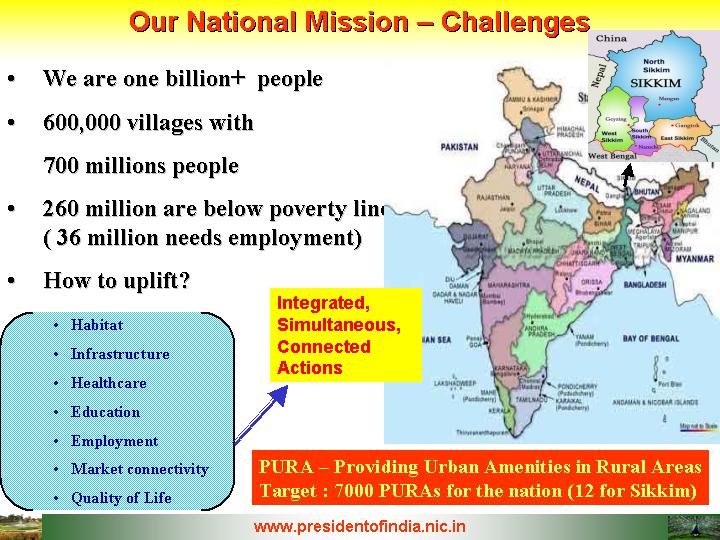

Integrated Action for Development
To meet the needs of one billion people whose number will further increase, we have a mission of transforming India into a developed nation. We have identified five areas where India has core competencies for integrated action:
(1) Agriculture and food processing
(2) Reliable and Quality Electric power, Surface transport and Infrastructure for all parts of the country.
(3) Education and Healthcare
(4) Information and Communication Technology
(5) Strategic sectors.
These five areas are closely inter-related and when effectively addressed, would lead to food, economic, energy and national security.
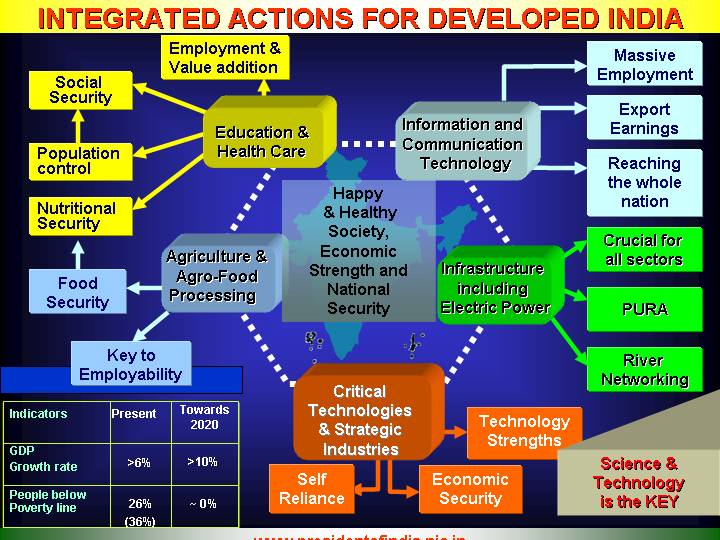

Engines for Growth
Emphasis should be on full utilization of natural and human resources of the region to meet the demands of the modern society. We should also remember that about 50% of our population is young people, with aspirations for a better life. Value addition to Agriculture, Manufacturing and Service sectors of the economy, building on the regions? core competencies and technologies, will lead to high income growth rate and employment potential. The engines for growth will be launching of the five national missions viz. water, energy, education and skills, infrastructure and employment generation, which will enable achievement of 10% GDP growth rate per annum, sustainable for a minimum period of ten years. Developed States result in developed India.
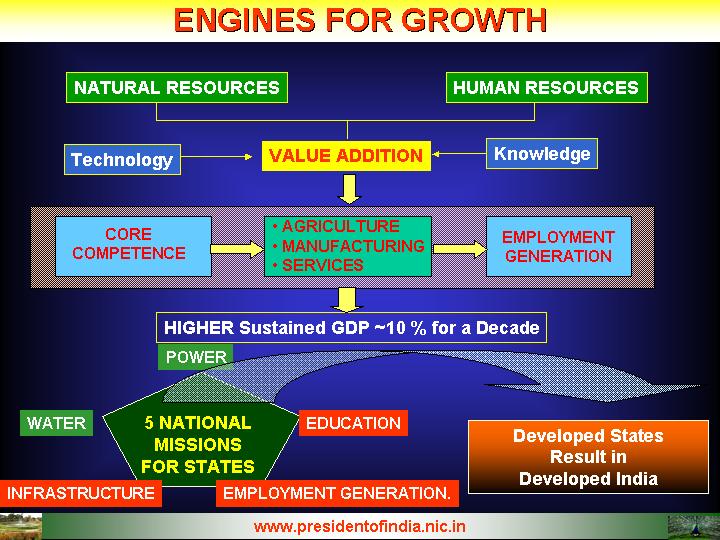
Sikkim is a unique state located in the inner ranges of Himalayas with altitude ranging from 300 meters to 7000 mtrs above sea level with a habitable area restricted to the altitude of 2100 metres. The urban population of Sikkim is only 12% of the total population of the State. This is a unique situation, which needs the programme like Hill PURA (Providing Urban Amenities to Rural Areas) for integrated development of Sikkim.
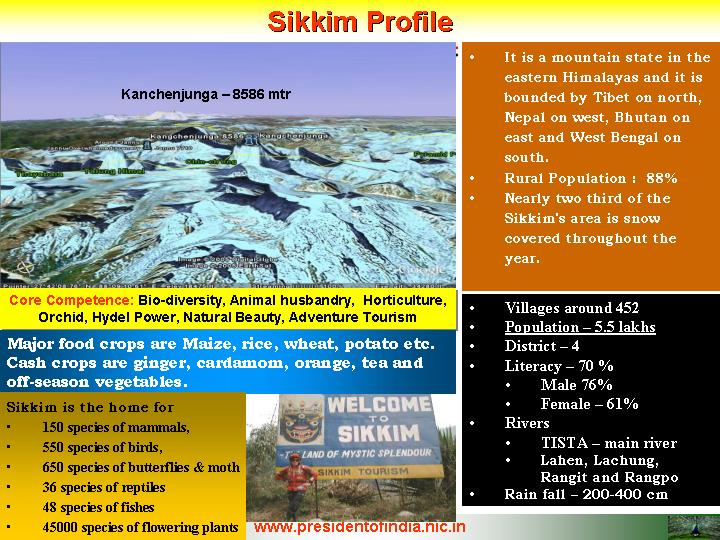

Human development index
With all these favourable factors, what can be the missions for Sikkim? There cannot be any other mission, other than removing the poverty of the people and bringing prosperity to the State in a time bound manner. At this stage, let me share with you a Development Radar brought out by the Planning Commission for various states. The boundary of octagon indicates the maximum achievements of various indicators of development. The smaller octagon represents the national average. While we appreciate you for your achievements in provision of drinking water and to a certain extent on literacy, formal education and life expectancy, it is essential that the Hon?ble Members must realize that Sikkim has got the potential to remove the poverty altogether, increase per capita expenditure and reduce infant mortality rate. They can definitely improve the Human Development Index rating from the existing 18 and aspire to become within the first few.
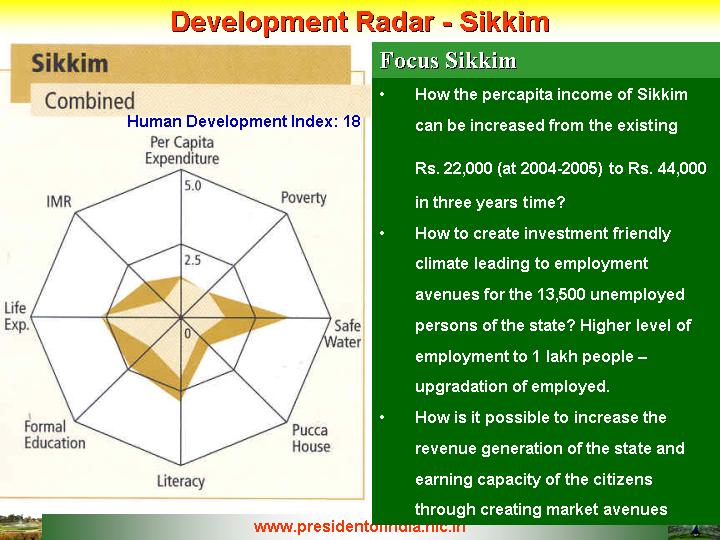

Goals & Strategies for Sikkim
Considering the core competence, the missions for Sikkim are: literacy, employment opportunities and affordable health-care for all, development of infrastructure including provisioning of comprehensive physical, electronic and knowledge connectivity. This will lead to prosperity for all by doubling the per capita income from the existing Rs.22,000 to Rs.44,000/- within the next five years through the use of Sikkim?s core strengths, and formulation of progressive agricultural, horticultural and industrial policies towards a well developed productive state.
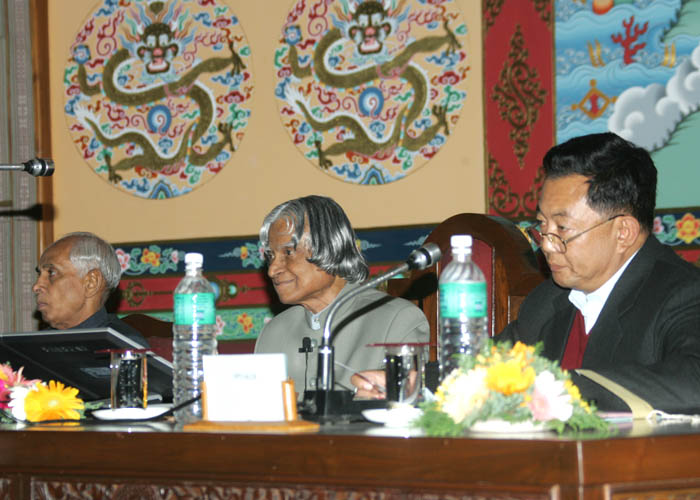

Integrated Missions for Economic Development of Sikkim
Dear Members, to realize these goals, I would now like to propose eight missions for Sikkim. These are Literacy, Skills, Education and Health Care, Development of Infrastructure, Providing Urban Amenities in Rural Areas (PURA), Medicinal, Floriculture Aromatic Plants, Horticulture, Hydro Power Generation, Tourism and Creation of Secure Economic Zone. I would like to discuss these missions in detail with you.
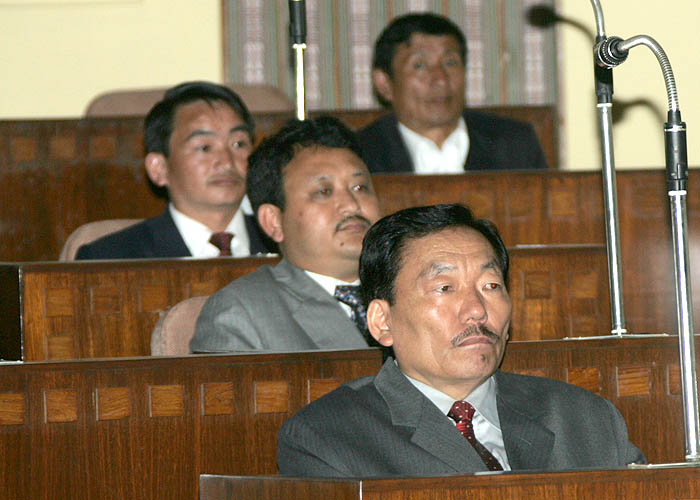

Mission #1:Literacy, Skills, Education and Health Care.
I am happy to note that the literacy of Sikkim at present 70% which has to be increased to above 90%. This can be achieved if each of the approximately 4,000 college students and 15,000 high school students reach out to train and educate the people who cannot read and write. Then, we shall witness a unique experiment where nearly 19,000 educated population reaching out to around 1.5 lakh people who today do not know how to read and write. Each student will have to provide literacy to only 4 persons during a year. This will ensure removal of illiteracy within the next two years. This will be complementary to the other adult literacy programmes organised by the State and Centre. I assure you that the results will be excellent leading to prosperity and happiness of Sikkim.
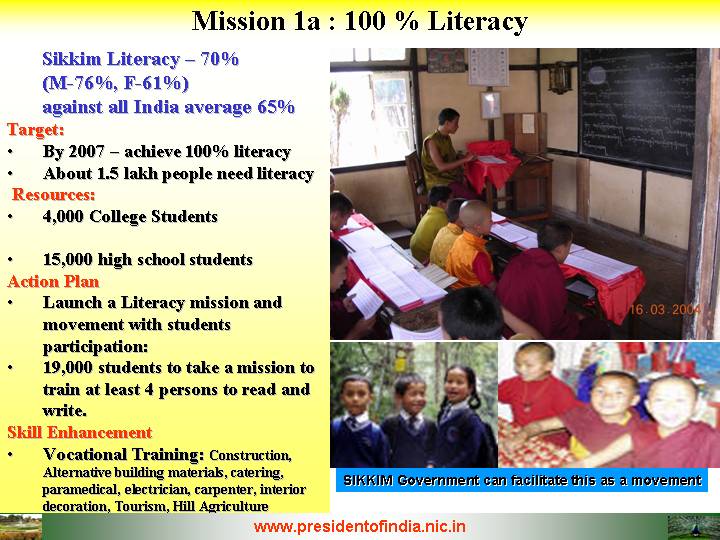
Skills: While literacy and numeracy are essential for every citizen, they are insufficient to acquire gainful employment. Having the right and economically relevant skills, becomes critical for those who only have education upto the levels of 8th std/10th std/12th std pass. A large percentage of our young people belong to this category. They need to be trained to get into an employment or self employment. Skills can be in construction, repair, hotel work, hospital related paramedical work or retailing or as electrician or carpenter. There are several kinds of work. Modern competitive economy demands correct and quality skills. It is our duty to empower the citizen with such skills.
Value based creative Education: Our aim is to develop human resources with value system and entrepreneurial focus, leading to arrest the tendency of school dropouts and the generation of enlightened citizens. It can be achieved through incorporation of two models of education practiced in different parts of the country. I have come across Prof. MR Raju model at Peddamiram, Beemavaram District of Andhra Pradesh, where character building commences in the age between three to five. The child learns to become creative through love and affection, hygienic practice and nutrition. In the second model, practiced by the Azim Premji Foundation, literacy improvement is achieved through accelerated learning with the help of computer-based creative content for 1st to 8th standard. Children learn by themselves using computers. Teachers, parents, School Committee members become accountable for ensuring prevention of dropouts. One of these models can be adopted by Sikkim for preventing drop outs from rural schools.
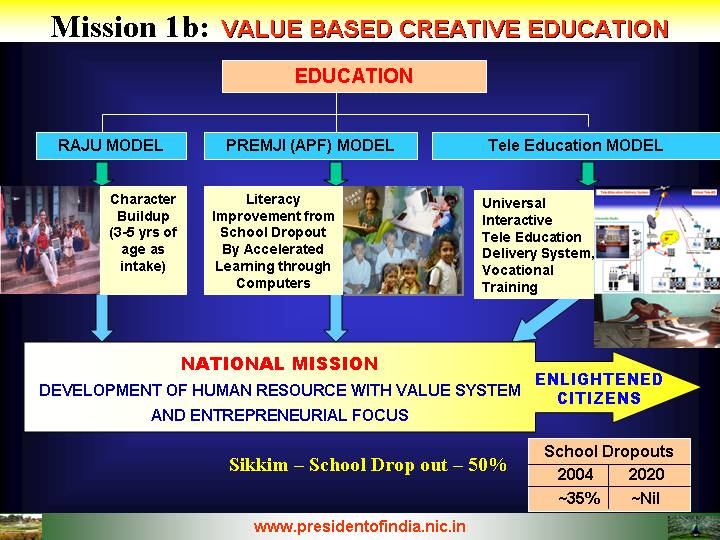
Health Care: I suggest institution of a unique insurance model for Sikkim, which will enable availability of health care to all within a short distance. For providing comprehensive quality health care, we suggest citizen?s make a contribution of about Rs. 5/- per month and a matching Government contribution of about Rs. 5/-, which will lead to a Consolidated Health Fund of Rs. 6 crore per annum for the Sikkim citizens. The Government contribution is only Rs. 3 crores. This insurance system will pave the way for every citizen of Sikkim to avail the services of any high-tech hospital for treatment, which is within the purview of this insurance scheme. This unique Health Insurance Model will include an Information Communications Technology assisted Medical Advisory System and Health Awareness Education over and above quality medical and surgical treatment and services to all the people. Such a model is already in operation in Karnataka providing insurance cover for nearly 25 lakh people. I would also recommend Sikkim to invite corporate hospitals to set up their super specialty hospitals in this State supported by tele-medicine and mobile clinics so that they can, not only provide quality healthcare to Sikkim residents but also promote world class medical tourism.
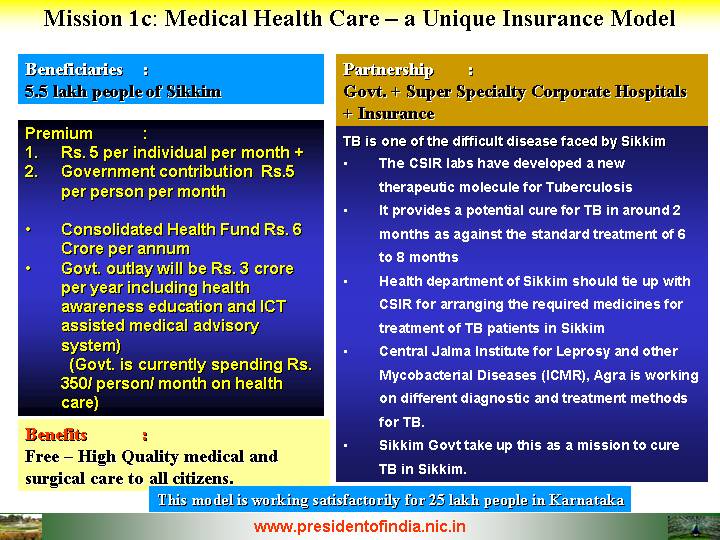
I understand TB is one of the difficult disease encountered by Sikkim citizens. The CSIR labs have developed a new therapeutic molecule for Tuberculosis. This molecule has shown the potential to cure TB in around 2 months, as against the standard treatment of 6 to 8 months. This breakthrough is very important. I would suggest the Health Department of Sikkim Government to liaise with the CSIR for arranging the required medicines for treatment of TB patients in Sikkim. Also, the Central Jalma Institute for Leprosy and other Mycobacterial Diseases (ICMR), Agra is working on different diagnostic and treatment methods for TB. I would suggest Sikkim Government to seek the medical and research assistance of this Institute for curing the existing cases and preventing future cases of occurrence of TB in Sikkim. Sikkim has also been brought under the revised National TB Control Programme and there is an effort to detect the cases early and provide quality treatment to the patients.
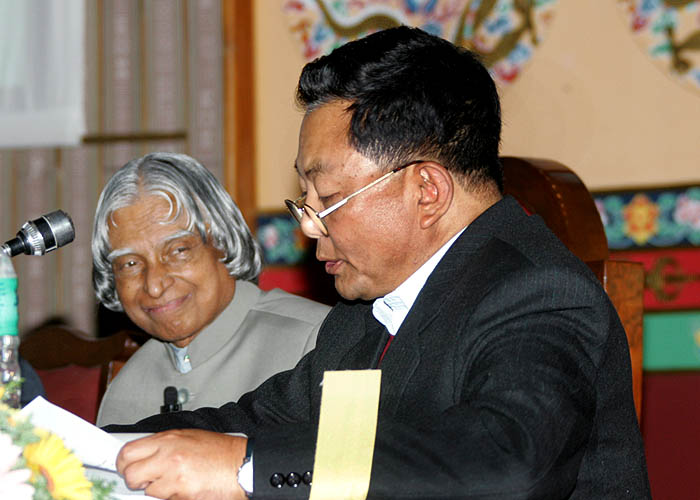

Mission #2: Development of Infrastructure
Sikkim is endowed with a climate which can produce quality flowers and orchids and supply it competitively in the global market. Also, the geographic location of Sikkim with natural height and the rivers makes it an attractive place for generation of hydro electric power. The bio-diversity, scenic value, the flora and fauna and the religious places makes it a good tourist destination. All these activities can be successfully carried out only if the connectivity to Sikkim with the external world and the internal connectivity between different places are available as is found in many hill resorts in different parts of the world. Hence, I am of the view that the development of Sikkim is directly related to development of infrastructural facilities which can be created within the next three to five years. Firstly, there is a need to establish a Air Port at Gangtok which will enable arrival of both national and international tourists and assist in the marketing of products such as orchids, flowers and medicinal plants to different parts of the world. Secondly, there is a need to reinforce the internal connectivity with good roads within Sikkim so that materials and equipment needed for establishment of power plants and transportation of produce to air terminal can take place without difficulty. One of the indicators of development of a state is the availability of road for square kilometer area of the state. In advanced countries like Switzerland every square kilometer of area has 1.7 km length of roads whereas in Sikkim it is only 0.67. This shows the need for increasing the road density. Also, we can consider establishing certain ropeways for connecting high altitude landslide prone locations.
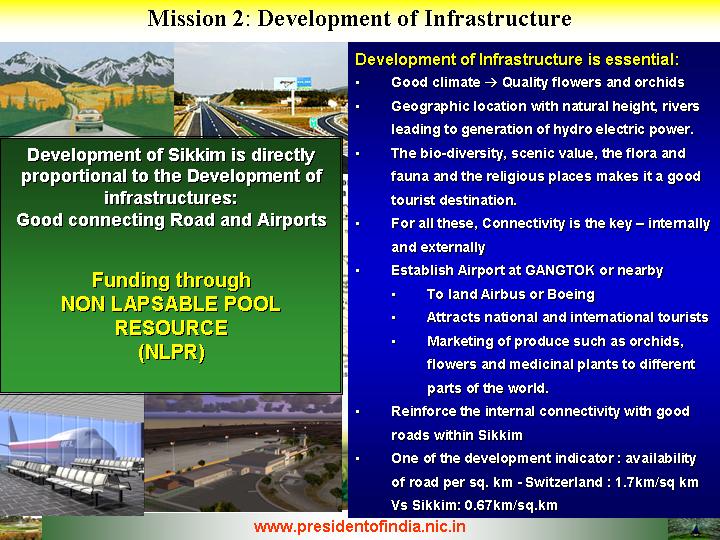

Mission #3. Providing Urban Amenities in Rural Areas (PURA)
I have studied about Sikkim terrain and the districts and towns. Sikkim and its regions require a unique PURA concept due to its terrain. I would recommend creation of total 12 PURA units, three for each district, since 87% of the people live in rural areas. This will provide four critical connectivities between villages located in different altitudes enabling accelerated economic growth: physical, electronic and knowledge connectivity, leading to economic connectivity. I shall describe these in detail.
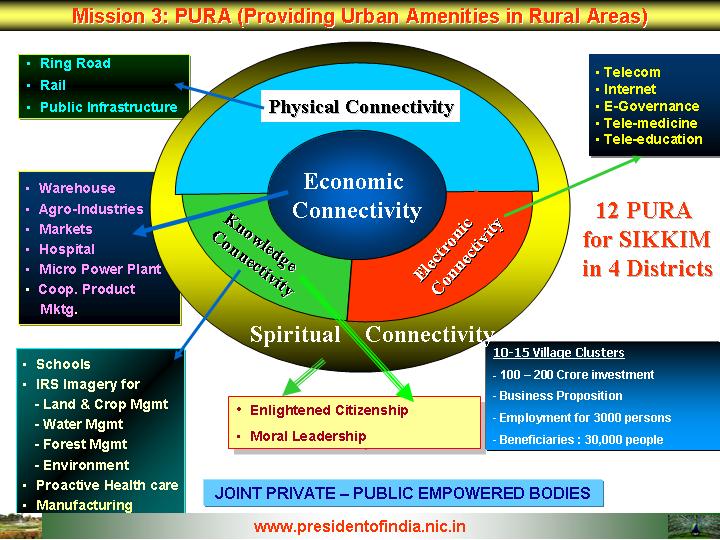
Essential Connectivities These are: physical connectivity of village clusters through quality roads and transport wherever possible keeping in view the terrain condition; difficult places may have to be connected through innovative rope ways. In the long run this will become economically viable. It is essential to build in safety features even if they increase initial and operational cost. Electronic connectivity through tele-communication with high bandwidth fiber optic cables and V-Sat terminals reaching the rural areas from cities and through internet kiosks; Knowledge connectivity through education, skills training for farmers, artisans and craftsmen and entrepreneurship programmes. These three connectives will lead to Economic connectivity through starting of new enterprises with the help of banks, micro credits and marketing of the products. The integrated method envisages a mission mode empowered management structure with executive powers at the local implementation levels and by reducing the transactional costs through simplification of procedures of governance.
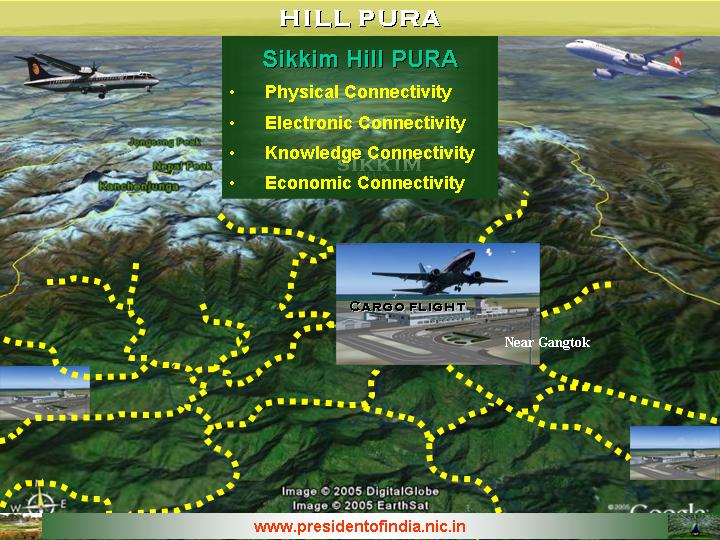
Creating such village clusters through hill PURA depending upon the region and population will cost between Rs 50 to 100 crores per cluster. A single hill PURA will have the potential to provide employment for 1000 to 2000 people directly and nearly 4,000 people indirectly. This has to be done by creating new market driven enterprises brought in by investors. If the industrial areas particularly agro processing, special hill specific natural products (with value addition) and high value artisanal products are marketed well, they can attract investors and thus lead to local wealth generation. I would suggest each PURA to become a tourist centre keeping in view the special tourist attraction of Sikkim. Some of the small scale enterprises for PURA could be agro processing industries, handloom/craftsmanship products, precision engineering tasks such as gem cutting and tannery products.
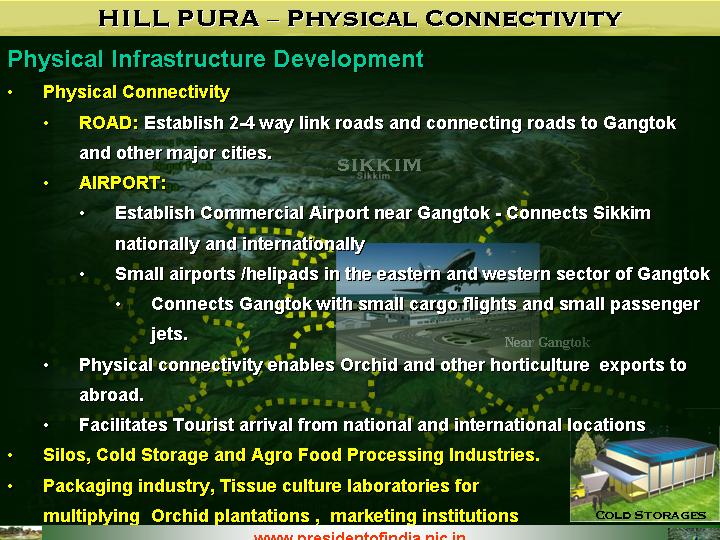
We need to promote entrepreneurship in the rural areas and equip people with skills for their own self-employment, meeting the needs of modern economy and society. Some of these persons may also turn out to be innovators and employment generators.
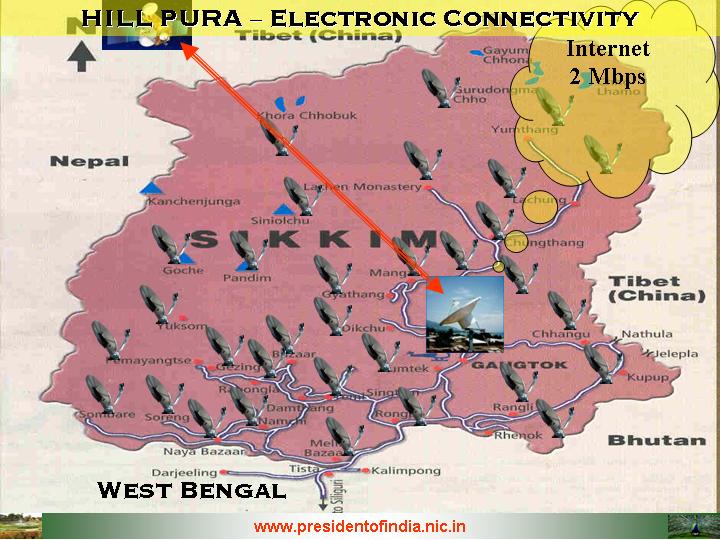
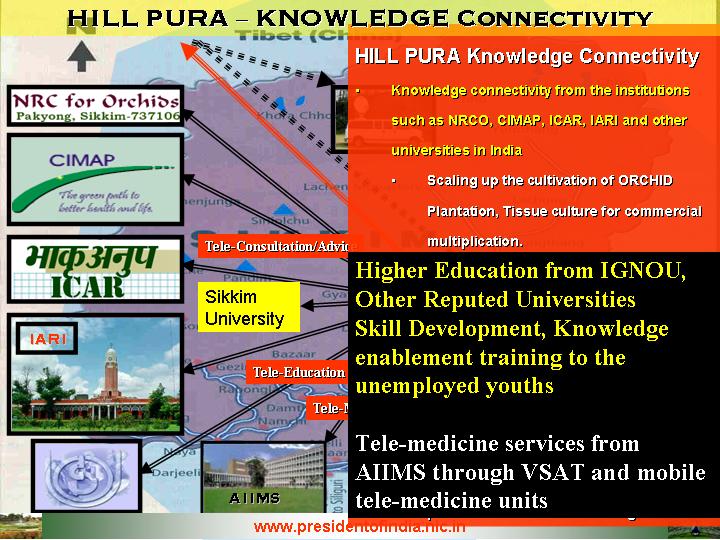
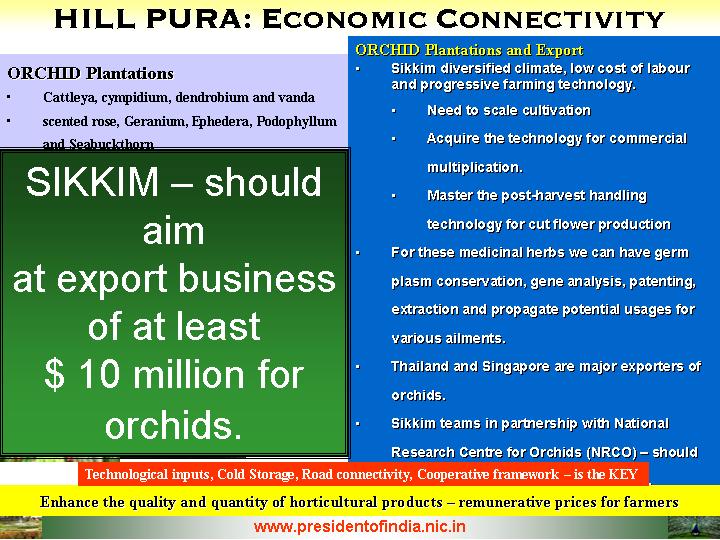

Mission # 4 : Medicinal, Floriculture and Aromatic Plants
Sikkim has all the potential for development of a successful orchid industry on scientific basis. It has varied and suitable climate and almost important commercial varieties of orchid including those of Cattleya, cympidium, dendrobium and vanda which can be grown for cut flower production. With this strength, Sikkim should work on a mission of capturing at least $ 10 million of export business for orchids. This is definitely possible due to our diversified climate, low cost of labour and progressive farming technology. We have to only get suitable planting material for large scale cultivation and also acquire the technology for commercial multiplication. We should also master the post-harvest handling technology for cut flower production. Thailand and Singapore are major exporters of orchids. Sikkim teams in partnership with National Research Centre for Orchids (NRCO) can definitely acquire the competence through a national and international connectivity and achieve the mission of exporting at least $ 10 million of Orchids within the next three years.
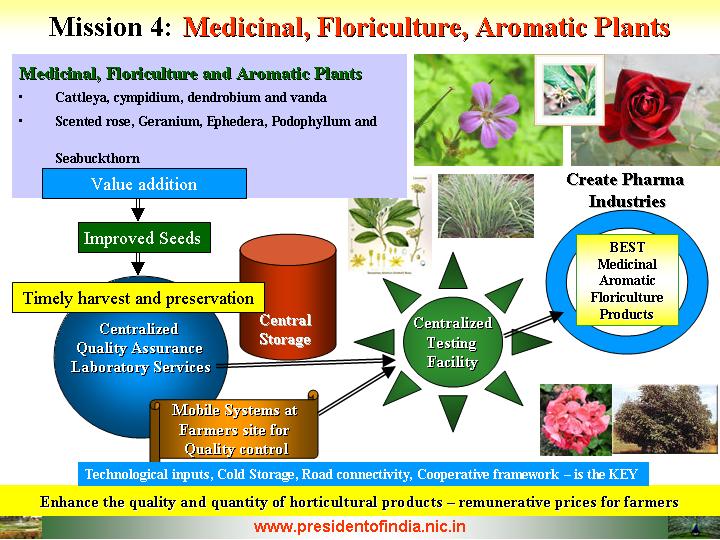
In addition to the above, scented rose, Geranium, Ephedera, Podophyllum and Seabuckthorn are some of the medicinal and aromatic plants which can be grown in Sikkim. For these medicinal herbs we can have germ plasm conservation, gene analysis, patenting, extraction and propagate potential usages for various ailments. Also, there is a need to have centralized quality assurance laboratory services through mobile systems at remote sites so that the farmer can know the qualitative and quantitative value of his product and get the best price. A mechanism is required for making central storage and testing facilities for the farmers in the key locations so that they can export their product directly instead of handing over to middlemen at an uneconomic price. Since Sikkim has 4500 species of flowering plants some of the popular plants can be grown in cooperative farms for marketing in Indian metros and abroad.
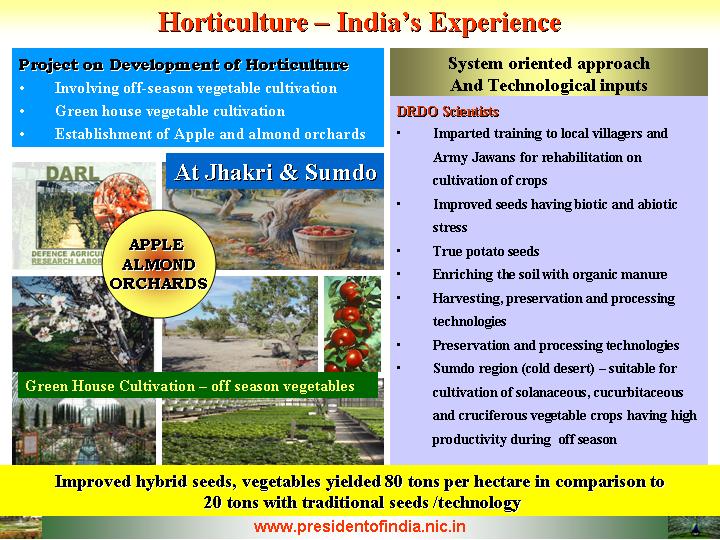

Mission # 5: Horticulture
I would like to share my experience of one of the Units of DRDO laboratory with Himachal Pradesh located in Jhakri, Puh and Sumdo. DRDO had taken up a project on the development of horticulture involving off-season vegetable cultivation, green house vegetable cultivation and fruits. The agricultural scientists of the laboratories imparted training to the local villagers and army Jawans (for resettlement purposes) on the cultivation of all these crops. The technological inputs provided to the farmers included improved seeds having tolerance to biotic and abiotic stress, true potato seeds, enriching the soil with organic manure, harvesting, and preservation and processing technologies. Certain districts in Sikkim are suitable for cultivation of variety of vegetable crops having high productivity during off season. With improved hybrid seeds, vegetable yield can be increased to 3 to 4 times in comparison to traditional seeds and conventional technology. I would suggest Sikkim to invite agricultural scientists working in Leh area for getting technical advise on such value added plantations. Sikkim is famous for its special variety of cardamom and ginger. Both these items are now being sold without value addition. It can become a great wealth generator for the state, if value added cardamom and ginger are sold in the national and international market.
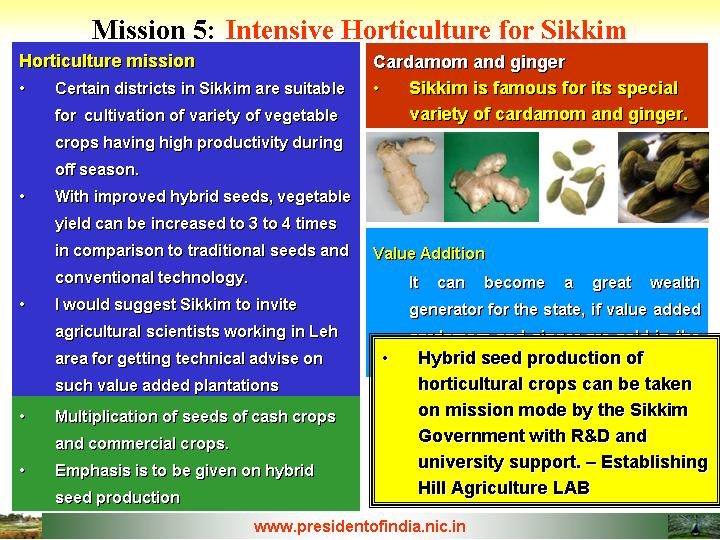
Another important wealth generator for Sikkim is the multiplication of seeds of cash crops and commercial crops. Large quantity of these seeds is being imported in the country. Emphasis is to be given on hybrid seed production. Farmers who are producing the seeds are getting very remunerative prices in the national and international market. Hence, I consider that there is substantial scope for production of these seeds by many farmers in the state. Hybrid seed production of horticultural crops can be taken on mission mode by the Sikkim Government.
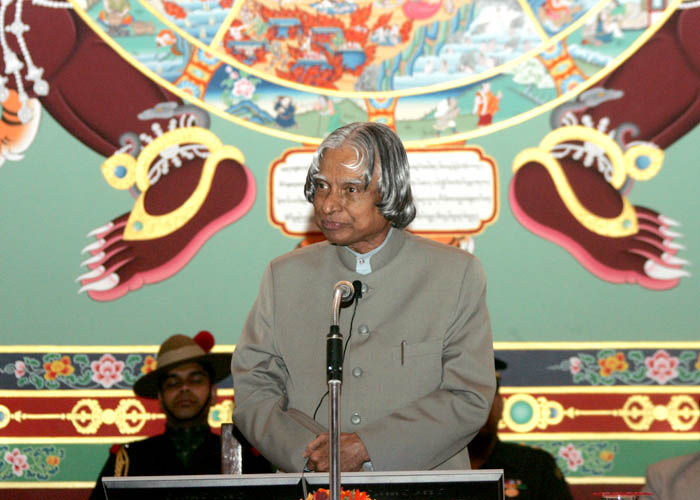

Mission # 6: Hydro Power Generation
The innumerable streams and rivers flowing down the Himalayas provides Sikkim the potential of generating approximately 8000 MW of electric power through hydro electric process. The demand for Power is constantly increasing and it is an important infrastructural requirement for the growth of the state and the nation. At present nearly 100 MW of power is available through hydel sources. Also, I notice that work is progressing on hydel projects having installed capacity of over 700 MWs including one large hydel project with 510 MW capacity with financial support from state government, MNES and borrowings. In addition there are 21 schemes allotted to different private sector agencies and are in DPR or investigation stages. These schemes have a potential to generate over 4000 MWs of power. I would suggest that the Sikkim Government can take up these projects on mission mode, so that by 2010 all the additional 4700 MWs of power becomes available to the state. This additional power will cater to the industrial and agricultural needs of the State and assist Sikkim in increasing the pace of development. The surplus power can be marketed to the main grid and can become a wealth generator for Sikkim.
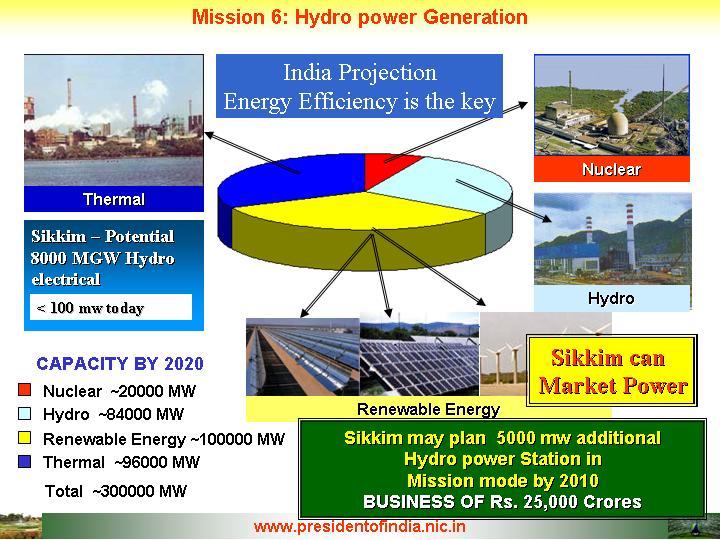

Mission # 7: Tourism
Tourism is a major mission and has a tremendous potential for growth in this beautiful territory. The unique contribution that Sikkim has made to tourism is the preservation of pilgrim centres, architectural and civilizational heritage. The website of Sikkim Government gives some basic information about hotels and trekking routes etc, but it still does not exploit the visual power of the web. I would request the IT engineers from Sikkim to create several walk through for the best Tourist spots in Sikkim and also for the hotels and guest houses. An audio visual aid can be freely distributed for the visitors so that they can also enjoy the tours in their own privacy. What is required now is to implement the new Tourism Policy, a stress on product diversification and dispersal of tourism activities in far-flung areas. Additionally, health tourism, adventure tourism including trekking and eco-tourism can also be a part of the tourism package. The hot springs located in different parts of Sikkim can also attract tourists.
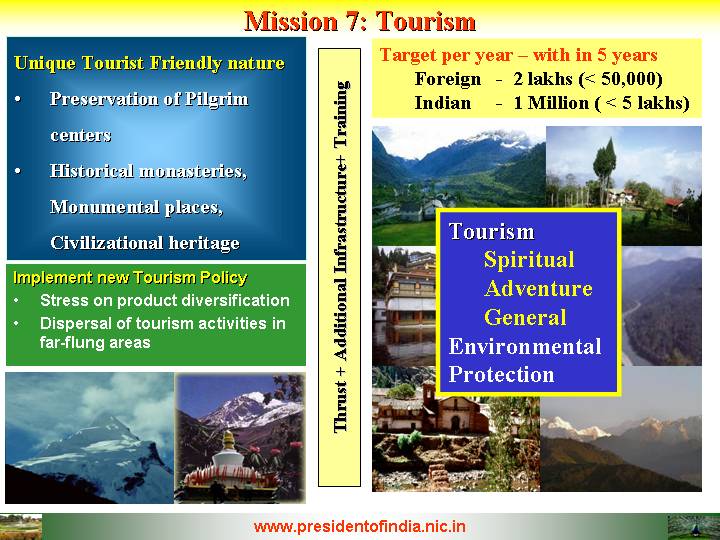
Sikkim with its unique ?tourist friendly nature? can set a target of its Indian tourist inflow to one million per year and enhancing foreign tourist inflow to two lakhs per year within the next three years when the infrastructure would have improved considerably. This would demand thrust in creation of additional infrastructure, and high level of training to the youth to handle the higher volume of tourism. The unique features are Heritage Architecture, Varieties of Indian food, Spiritual solace, High Altitude Trekking and Mountain Sports, Tribal Culture, Environment and Handicrafts.
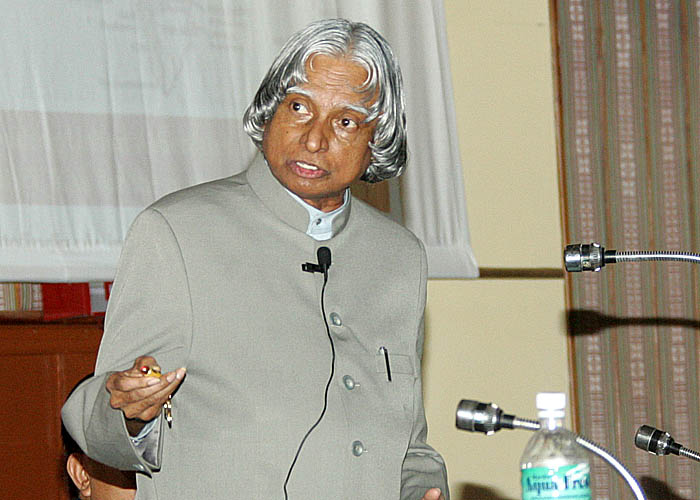

Mission # 8 Creation of Secure Economic Zone
Both Central and State budget normally will have a core task of GDP growth of the state and also the employment generation. This core task will fructify only by investing the budgeted fund in agriculture and food processing, investment in industries including small scale industries and service sector particularly in the IT enabled services. A method has to be found, how the development in all the three sectors of the economy can be evolved within the Sikkim environment. That is, in this beautiful natural environment; a productive industrial environment has to be created. It is in the hands of this Legislative Assembly. How it can be done? I have given few thoughts. Let me share with you. I suggest the Sikkim Legislative Assembly to consider forming one Secure Economic Zone in the state depending upon the core competence, particularly in the production of IT, BT products, agro-food processing, handloom and handicrafts etc.
What can be the unique ambience of the Secure Economic Zone?
a. Sikkim government has to provide land (about 2000 hectares) in a particular area, power, and water with physical and electronic connectivity.
b. Fast single window clearance for attracting the investment.
c. Sikkim Legislative Assembly?s assurance for promoting proactive policies for ensuring uninterrupted work culture in the Secure Economic Zone.
d. Employees have to be partners in these enterprises.
This Secure Economic Zone will attract the ICT, Bio-tech and small and medium industries to invest and increase the economic activity in Sikkim. These facilities should be created using the Non Lapsable Pool Resource Fund available for the North Eastern States.
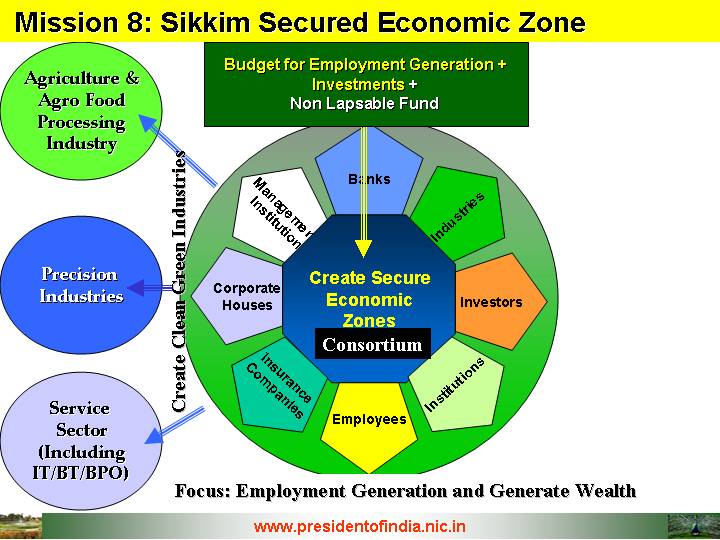

Entrepreneurship
All these eight missions which I have discussed will require generation of large number of entrepreneurs in the State through entrepreneurship programmes. The academic institutions in Sikkim generate about 380 graduates per year and the 10th class and 10+2 students will be around 5000. All of them will seek employment either within Sikkim, outside the state or abroad. Now the school syllabus and university syllabus have to be integrated with entrepreneurship courses. The students at the end of the course should get a certificate or a diploma. This will enable students qualified in these schools and colleges, to have the confidence that they can start the small enterprises in agriculture, manufacturing or services especially in the areas of horticulture, medicinal and aromatic plants, tourism, power plants and creation of PURAs. Banks have to be entrepreneur friendly and should give them venture capital and support these young entrepreneurs and their creative ideas. This system will change the situation in all the states, particularly in Sikkim by generating employment providers rather than employment seekers.
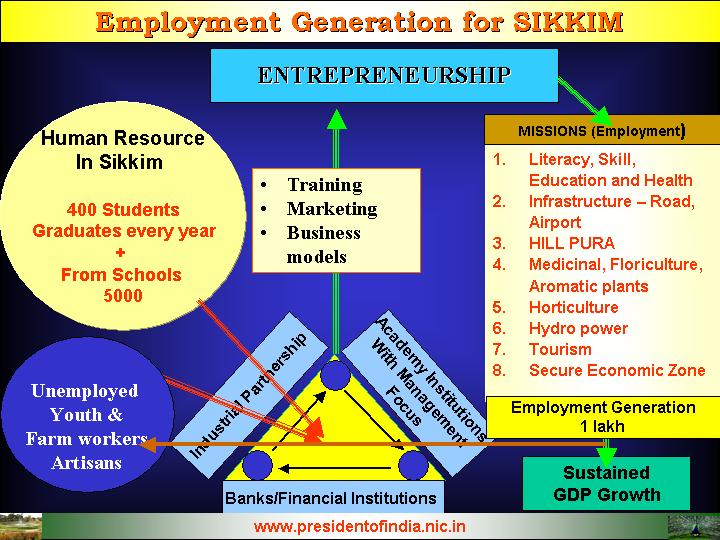

Eight Immediate Missions
Dear Members, may I now summarize the eight important missions for your consideration and implementation for sustained prosperity and empowerment of Sikkim:
1. 100% literacy, skills and Health Care for all through Medical Insurance.
2. Development of Infrastructure - Airport nearby Gangtok and small airports/helipads in western and eastern region.
3. Establishing 12 Hill PURA clusters.
4. Medicinal, floriculture and aromatic plants - Orchid farming for national use and export - $10 million in 5 years.
5. Horticulture
6. Establishment of 4700 mega watt additional hydel power on mission mode through private sector build operate own scheme within three to five years.
7. Tourism mission with the target of one million internal tourists and two lakh international tourists within the next three years.
8. Creation of Secure Economic Zone
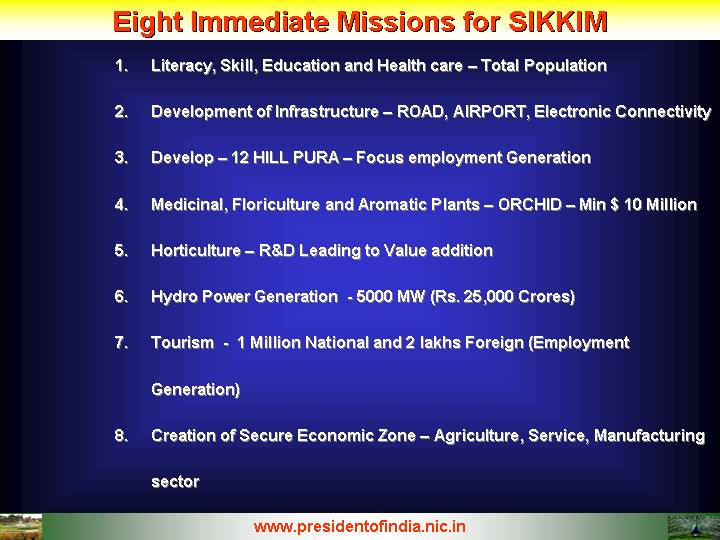

Conclusion
I have so far, given an outline of eight missions, which can propel Sikkim into an economically developed state and thereby the Nation is enriched.
Nature has given Sikkim such a beautiful atmosphere, spiritual peace, amity, unity and above all a wonderful and bountiful land. Sikkim is a natural resource rich State. What is needed is innovative policies, creation of confidence, enthusiasm and motivation among people, provide essential infrastructure in the form of connectivities and sustained hard work to achieve the development missions. Two lakh fifty thousand youth of Sikkim are the most powerful resource to transform these missions into reality. They will definitely ensure that Sikkim becomes a developed State by 2015. Sikkim has to have a 10 year mission to transform into a economically developed state with spiritual civilizational heritage.
My best wishes to all of you for success in these missions.
May God bless you.
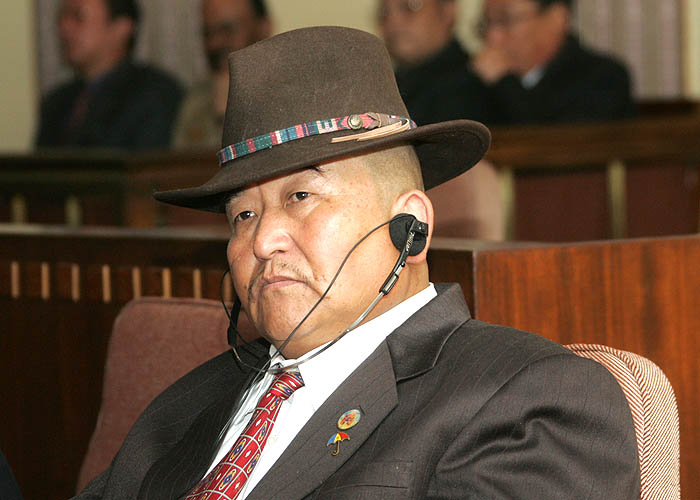
<<Back
|
|